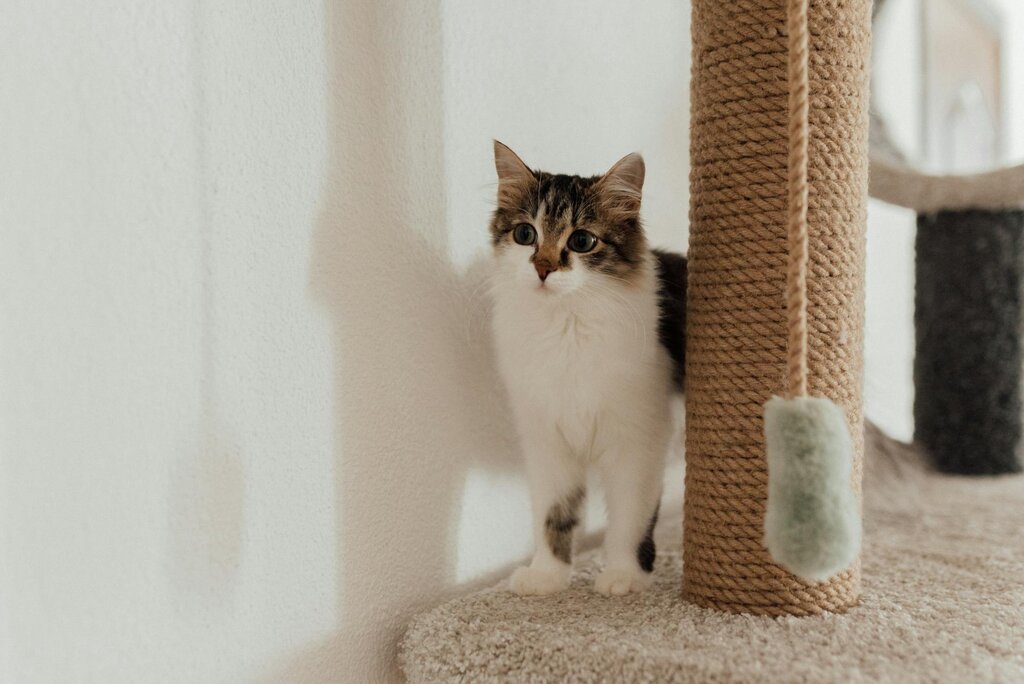Last Updated: 29/03/2025
How to Stop Cats from Scratching the Furniture
How do you stop your cat from scratching the furniture? Our Vet team has some great solutions here
Author: Dr Elise Barry BVSc (Hons)
Reading Time: 11 minutes - short read
Scratching is a normal cat behaviour. It allows them to shed their old outer nails, mark their territory and provides a convenient back and limb stretch. Yet for some owners this healthy habit is frowned upon when the household furniture becomes shredded and clawed.
Follow these 5 tips to keep save your sanity (and furniture!) from clawing kitties.
Provide appropriate places for your cat to scratch
Cats need to be given an appropriate scratching surface. Some cats like to scratch up and down (vertically mark) so therefore a scratching post or tree is recommended. Whilst others prefer horizontal marking so a substrate on the ground (like a cut up square of old carpet) should be provided.
Cats need to be directed to safe clawing sites. If furniture scratching has already been established then a deterrent should be used on the furniture and a replacement scratching material or object provided right next to it. Over time you can slowly move the scratching substrate or object to a suitable location away from the furniture.
Deter inappropriate scratching
To stop cats scratching the furniture you can cover the site in double-sided tape or Sticky Paws. Bubble wrap, velcro and alfoil also discourage clawing. Scent deterrents like NO Scratch Spray can also be sprayed at the site. The furniture can be draped with a material sprayed with the deterrent, like a towel, newspaper or sticky-taped cotton wool. Care should be taken to not directly spray furniture in case staining occurs.

Try pheromones
Feliway is a manmade version of the odourless pheromone normally left by cats when they rub against objects in their environment. This pheromone is usually released by your cat when he or she feels happy or content and is also used to mark territory. When used correctly, Feliway can help to reduce your cat's stress levels and combat marking behaviours like scratching or spraying.
If your cat is scratching inappropriately at multiple around the home, the Feliway Diffuser should be used in the room where your cat spends the most time. If scratching occurs in just one particular area, then the Feliway Spray can be used to spray just that area. The Spray can also be used in addition to the Diffuser if required.
If using the Feliway Spray, it is important that you do not spray the areas where you want your cat to scratch, such as scratching trees and posts. Spraying these areas will prevent your cat from using them!
Want to know more? Take a look at Your Guide to Using Feliway.
Reinforce appropriate scratching
To keep your cat clawing at the right site, a Catnip Spray can be applied to the appropriate scratching place. Catnip tends to increase cats playfulness and when sprayed on new toys, or scratchers, can encourage your cat to use them. There's also a range of catnip stuffed toys available to keep your cat or kitten entertained.
For more information, take a read through What is Catnip?
Nail trimming
Although a kitty manicure does not prevent scratching it can reduce the damage done by sharp nails whilst the training is underway. Invest in some nail clippers to help keep your cats nails short.
Trimming nails of cats who go outdoors is generally not recommended as it can stop them from being able to escape upwards by climbing from dogs or other dangers in a hurry.
Solutions to stop your cat from scratching furniture
Further Reading
Want to read more? Check out our other articles:
History
Our experts continually monitor the health and wellness space and we update our articles when new information becomes available.
Apr 2023
Written by Dr Elise Barry BVSc (Hons)Dr Elise Barry BVSc (Hons)
Veterinarian
Dr Elise graduated from the University of Sydney in 2007 and worked in mixed practice in the Central Tablelands before relocating to South East Queensland to work in small animal practice. Dr Elise has completed a diploma in wildlife management and furthered her studies in ophthalmology and animal behaviour. She enjoys helping pet owners to understand their pets and keep them happy and healthy.

